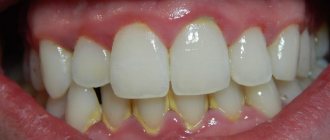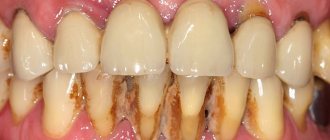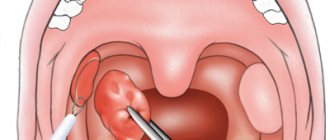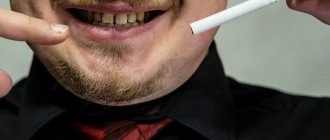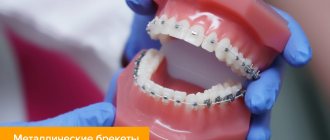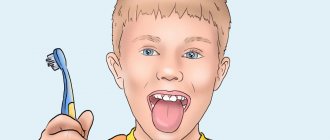From this article you will learn:
- what does tartar look like - photo of dental deposits,
- reasons for education,
- how to remove stones from teeth.
The article was written by a dentist with more than 19 years of experience.
Tartar is completely or partially hardened soft microbial plaque that has not been completely removed through oral hygiene procedures. Tartar contains a large number of pathogenic bacteria, food residues, and calcium salts. The rate of tartar formation varies from person to person and depends not only on the quality of oral hygiene, but also on the characteristics of the diet, the composition and rate of saliva secretion, and other factors.
Stones on teeth can be supra-gingival or sub-gingival. The first ones are clearly visible and are located in the area of the necks of the teeth (Fig. 1-6). They usually have a dark or yellowish-brown tint. In the presence of tartar, patients always complain of accompanying symptoms - bleeding gums, bad breath, as well as swelling, redness or cyanosis of the gingival margin. And in the presence of subgingival dental deposits, in some cases it also affects tooth mobility and purulent discharge from under the gums.
Tartar: photo
Teeth stones consist of organic (10 to 30%) and inorganic (70 to 90%) components. The bulk of inorganic components are calcium salts - primarily calcium phosphate crystals. The organic components include: microorganisms, leukocytes, protein-polysaccharide components, epithelial cells exfoliated from the surface of the mucosa, amino acids, etc. It should be noted that the composition of tartar is not constant, and over time the proportion of organic components decreases.
Why is plaque on teeth dangerous?
Plaque is non-mineralized deposits that are accumulations of bacteria on the surface of the enamel. Both adults and children face this problem. First of all, plaque appears in areas that are difficult to reach with a toothbrush, such as fissures, interdental spaces, and contact surfaces. Also, deposits in the form of plaque can be along the edge of the gum, around the filling, on artificial structures.
The danger of plaque lies in its mineralization, that is, the transformation of soft deposits into tartar, which cannot be removed at home. Plaque is the main cause of diseases of teeth and gums, as it is a breeding ground for pathogenic microorganisms. If you neglect hygiene and don’t pay attention to the deposits that form, you can get a whole list of dental problems, including caries, periodontitis, and gingivitis. All this negatively affects the condition of the body as a whole, if a person is not interested in how to remove plaque.
- Due to the accumulation of bacteria in dental plaque, caries develops.
- Bacteria spread throughout the oral cavity, causing inflammation of the gums, gingivitis and periodontitis. Bleeding gums and bad breath are the consequences of dental plaque.
- Billions of bacteria in dental plaque are a source of infection that can reach any organ! That is why, for various diseases of the gastrointestinal tract, ENT organs, respiratory tract, and skin, it is always recommended to visit a dentist.
Cleansing methods
The soft layer of contamination on dental elements is an excellent breeding ground for pathogenic microflora. It multiplies exponentially, becoming a source of infection and, as a result, the cause of caries, gum problems and gastrointestinal diseases. Dentists have learned to effectively deal with the problem. Once upon a time, cleansing was carried out manually, it was not effective enough and was accompanied by pain. Now, special devices are used for cleaning, which allow 100% destruction of pathogenic flora. Experts recommend doing this procedure at least once a year.
The most popular method is cleansing using an Air Flow device. Mechanism of action: a solution containing tiny abrasive particles is applied to the surface of the enamel layer under pressure. They gently “bombard” plaque, destroying it and washing it away. Hard tartar is removed with an ultrasonic scaler. Once cleaning is complete, the enamel is polished and a fluoride varnish is applied to remineralize it.
Important: self-medication is dangerous. Do not try to remove dirt with sharp objects (needle, knife, etc.). This is fraught with injury to the gums, chips, and the risk of swallowing the cleaning tool.
Plaque on teeth under a microscope
It will be useful for everyone, without exception, to look at a photo of dental plaque under a microscope. Having seen how teeth covered with plaque look, it is unlikely that anyone will neglect hygiene.
With optical magnification, it is clear that plaque is a dense film of bacteria, including streptococci and staphylococci, veillonella, neisseria, diphtheroids, lactobacilli, leptotrichia, etc.
Let's highlight some features of soft deposits and figure out why plaque appears on teeth and why tooth enamel changes its color.
- The porous structure of plaque
promotes the accumulation of various substances, especially carbohydrates and dyes, which leads to rapid growth of deposits and darkening of teeth. - Electrostatic forces
attract positively charged microorganisms to the negatively charged sticky surface of teeth. In this case, there is a certain sequence: first the coccal flora appears, then, as the plaque thickens, rods and filamentous bacteria join it. - Features of bacteria
- plaque may contain pigment-forming microorganisms, giving it a specific shade (black or greenish).
A few hours after brushing, tens of thousands of bacteria per gram are present on the teeth (most of them are aerobic). They actively reproduce, their number increases to hundreds of billions (mostly anaerobic bacteria).
Classification
Tartar and the causes of its occurrence are different. In classical dentistry, it is customary to distinguish two types: subgingival and supragingival. Each of them has its own characteristics and is determined by different diagnostic methods.
Subgingival calculus
This type of plaque is recognized as especially “insidious”, as it forms out of sight: below the upper level of the gums. Dentists determine subgingival plaque using a probe. In addition, it is clearly visible during gum recession, when, due to a decrease in soft tissue, the roots and necks of the teeth open. Practice shows that subgingival stone in most situations has a dark color and high hardness.
Supragingival calculus
This type of tartar is located above the edge of the gum. In most cases, supragingival plaque is hard or clay-like and has a light yellowish tint. A superficial examination is sufficient for diagnosis. It is supragingival stones that become the reason for visiting a doctor. And already during the examination, the doctor may suspect the existence of hidden defects.
This is what supragingival stones look like on teeth – photos before and after cleaning:
Types of plaque
Surely many are familiar with this problem and have searched the Internet for information on how to remove plaque on teeth. It comes in different types - both colorless and pigmented.
✔ White, creamy, yellowish coating.
Such deposits form during sleep in conditions of poor nutrition and poor hygiene.
✔ Gray.
Associated with impaired mineralization of enamel, leading to its hypoplasia.
✔ Green.
Plaque on the front teeth of children and adults, the formation of which is caused by the activity of bacteria containing chlorophyll.
✔ Yellow
- plaque from tea on the teeth, from nicotine, food coloring, and also appears with age.
✔ Brown.
Often found in smokers and those who have amalgam fillings. People whose profession involves the manufacture of metal products from copper, brass and bronze are also at risk. In children, the formation of such plaque is observed when a large amount of unreduced iron is excreted with saliva.
✔ Black (Priestley's touch).
Black or dark brown spots on the inner and outer surfaces of baby teeth occur when pigment-forming bacteria are activated in the child’s mouth.
Tartar and oral hygiene –
After eating, a large amount of food debris remains in the mouth (primarily in the interdental spaces), and they cannot be removed by rinsing or chewing gum alone. For their vital activity, bacteria primarily use easily digestible carbohydrates, which are found in sweet and flour products. It has been established that in the absence of proper hygiene for only 1 day, the amount of bacterial plaque in the oral cavity increases at least 2 times.
But bacteria use nutrients not only for reproduction, but also for the production of special enzymes (enzymes), which allow bacteria to firmly attach to the surface of the tooth (24stoma.ru). In the absence of proper hygiene, individual pinpoint bacterial colonies attached to the teeth merge, forming a significant mass of bacterial plaque (Fig. 8-9). At this stage, plaque is still soft and can be removed with a regular toothbrush.
Accumulations of soft microbial plaque –
Next, there will be a gradual mineralization of soft microbial plaque, which will eventually turn into hard tartar. Mineralization (calcification) of soft dental plaque occurs through the deposition of proteins and calcium salts contained in saliva on the surface of bacterial colonies. The mineralization process occurs in combination with the layering of new bacterial colonies.
In parallel, microbial plaque releases toxins and inflammatory mediators, which trigger inflammatory phenomena in the gums. The main signs of gum inflammation are –
- bleeding when brushing teeth,
- redness or bluishness of the gums,
- pain in the gums,
- in later stages - suppuration from periodontal pockets, tooth mobility.
Pathogenic bacteria are very cunning, and gum inflammation is vital for them. The fact is that in the place where the gums adhere to the tooth there is a so-called periodontal groove, into which periodontal fluid is constantly produced from the gums in small quantities. This liquid contains a large amount of salts and proteins necessary for bacteria to quickly grow colonies. The launch of inflammation processes in the gums leads to a sharp increase in the production of periodontal fluid, and as a result, microbial colonies receive even more proteins and salts necessary for the calcification of tartar.
What causes plaque on teeth?
If you have plaque on your teeth, the reasons for its appearance must be identified first. It can be:
- hygiene problems, incorrectly selected products;
- errors in nutrition: lack of solid food and an overweight towards light carbohydrates, sugars, drinks with dyes (Coca-Cola, coffee, tea, wine, etc.). Bacteria destroy active carbohydrates from food and form acid that eats away enamel. In this case, it is not the quantity of sweets consumed that is important, but the duration of contact of sugar with the teeth;
- difficult hygiene during orthodontic treatment;
- smoking;
- metabolic disorders and diseases of the digestive system;
- malocclusion;
- taking medications (iron-containing, some antibiotics);
- features of the profession (working with copper, bronze and brass products);
- disturbed ratio of microorganisms in the oral cavity (predominance of pigment-forming bacteria, etc.);
- climate change is another reason for plaque on teeth (sea holidays, moving to another country);
- violation of the process of self-cleaning of teeth;
- age: over the years, the enamel becomes thinner and darker, and the question of how to remove yellow plaque on teeth becomes relevant. Priestley's plaque, on the contrary, appears on baby teeth at a young age, up to 8-10 years;
- heredity.
How to remove plaque in dentistry
First of all, the doctor conducts a diagnosis, determining the type and possible causes of plaque on the teeth. Consultation with other specialists may also be prescribed.
Even with ideal hygiene, plaque forms on the teeth over time, which can only be removed in a dental setting. Professional teeth cleaning is recommended for everyone, without exception, 1-2 times a year. Parents should take into account that it is impossible to remove Priestley’s plaque from a child at home, no matter how hard you try. Aggressive methods will only aggravate the situation and lead to damage to the gums or enamel of baby teeth.
How to get rid of yellow plaque on teeth? First of all, carry out professional oral hygiene. It consists of several stages.
- Preliminary indication.
Using special means (indicators), the hygienist carries out staining, that is, identifying all areas where deposits have accumulated. - How to get rid of plaque on teeth?
Carry out its gentle removal. The method is selected in accordance with the patient’s age and individual characteristics. Cleaning can be done using a sandblaster with glycine (for children). For adults - ultrasonic cleaning and/or plaque removal using the Air Flow method. - Enamel polishing.
Brushes and pastes of varying degrees of abrasiveness are used. - Remineralization.
The final stage of teeth cleaning is carried out to strengthen the enamel and prevent caries.
Plaque: how to get rid of it at home
Professional plaque removal is not a reason to relax and skip daily hygiene at home. Do not forget that plaque formation is continuous. This process can be slowed down if you follow certain rules.
- Eliminate/limit consumption of sugar, foods with dyes, and smoking.
- Use irrigators, flosses and other devices to clean hard-to-reach areas (space between teeth, braces, crowns, bridges, etc.).
- Carry out high-quality home hygiene (daily brushing of teeth in the morning and evening, and, if necessary and possible, after meals, competent selection of brushes and pastes, taking into account age and individual characteristics, correct technology for brushing teeth).
- Be sure to include in your diet foods that promote self-cleaning of teeth (for example, hard fruits and vegetables).
- Treat diseases of internal organs in a timely manner.
On the Internet you can find many popular ways to get rid of plaque. Lemon juice, soda, hydrogen peroxide and other available means are used. Before applying “homemade medicine” to your teeth, assess the risks. You can damage your enamel and increase your risk of tooth decay and gum disease. Consult a specialist! If there are no contraindications, you can use whitening toothpastes, but also after seeing a dentist.
Keeping your teeth healthy and avoiding many dental problems is actually not difficult. The main thing is to carry out thorough hygiene in compliance with the rules, do not skip preventive appointments and regularly have professional teeth cleaning.



